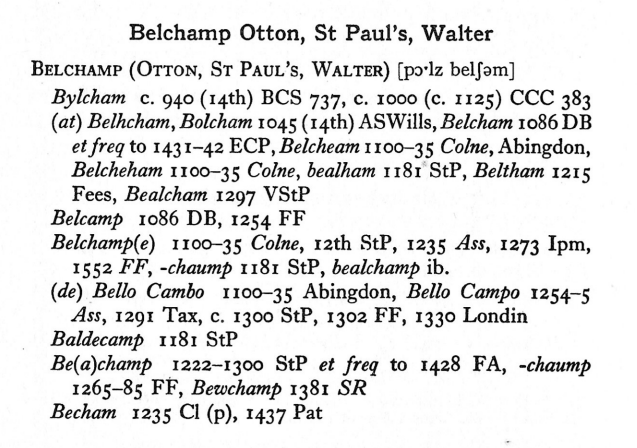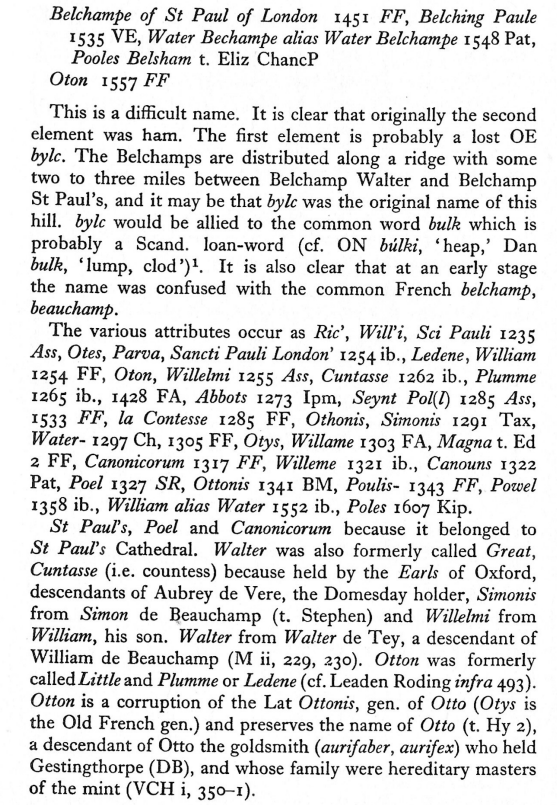Webmaster Notes
Belchamp St. Ethelbert - J.H. Round - VHC Victoria History - English Place Names Society - Ekwall
P. H. Reaney - Placenames of Essex
This document/book can be found in the Cambridge University Core Library.
There is also a copy in the Suffolk Public Libray system. I have made transscripts and scans of the pages for the communities that I feature on this website.
The section of the book relating The Belchamps can be found on my page on The Place-Names of Essex.
The entry for The Belchamps:
Belchamp Otten, St.Paul's Walter
From P.H.Reaney's "The Place-Names of Essex".

Top
The description of Reaney's Place Names of Essex
THE PLACE-NAMES OF ESSEX. By P. H. REANEY, under the General Editorship of A. MAWER and F. M. STENTON. Cambridge University Press, 1935. pp. LXII, 698. 255.
This is the twelfth volume of the publications of the English Place-Name Society, and in scope and arrangement follows the same general lines as previous volumes. After an interesting introductory note, which contains a brief survey of the place-names of Essex, and a number of conclusions to be drawn from a study of them, Dr Reaney deals exhaustively first with the river-, creek-, forest-, and road-names of the county and then with the place-names by hundreds and by parishes.
Field and minor names are considered in a separate section. There are also notes on the elements found in Essex
place-names and their distribution; on personal names compounded in place-names; on feudal and manorial names; and on
Celtic, Scandinavian and French names and their distribution.
As Dr Reaney points out, archaeology and tradition have done little to dispel the obscurity which enshrouds Saxon Essex.
So few finds have been made that we might conclude that the settlement of the county was little advanced in Anglo-Saxon times. A study of the place-names, however, makes this view untenable. Proof of the early date of settlement of Essex is afforded by the frequency of names in -ingas and -ingaham, generally admitted to be evidence of antiquity; by the number of names which are akin to those of places in Kent and Sussex known to have been settled early; by the existence of such names as Thundersley and Wodnesfold, which obviously date from a time of heathen worship;
and by the frequency of names containing a simple personal name, which may usually be regarded as early, since personal names of the simpler type were becoming unfashionable by the ninth century. Essex, in fact, affords an
excellent instance of the way in which place-name study can aid and supplement archaeology.
The maps given to illustrate the distribution of some of the more common place- name elements are a useful feature.
Amongst other things, they show the demarcation between areas in which earlier names, such as those in -ingas and ingaham are frequent, and areas which contain a preponderance of later woodland names, in -hey and -ley. It is evident that the early settlers tended to avoid the forests, and when they did settle in them it was near rivers or on the Roman roads.
In Essex there is little evidence of Celtic survival, except in the far northwest border, which was probably the last
district to be occupied by the Saxons. There is ......................
Essex Library
There is a copy of P.H.Reaney's book in the lending library. I have captured the entry for the Belchamps on my page for The Place Names of Essex
I have also attempted to make a list of Reaney's sources
Reaney and Birch
The history that was on the Village Hall website quoted a 904 date and attributed it
to P.H. Reaney, quoting Cartularium Saxonicum by Walter de Gray Birch.

